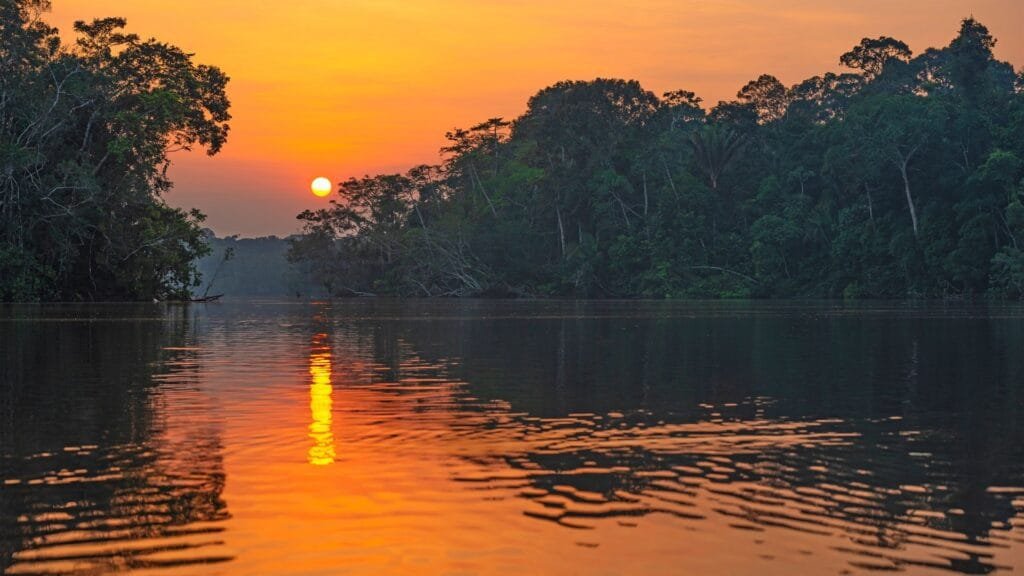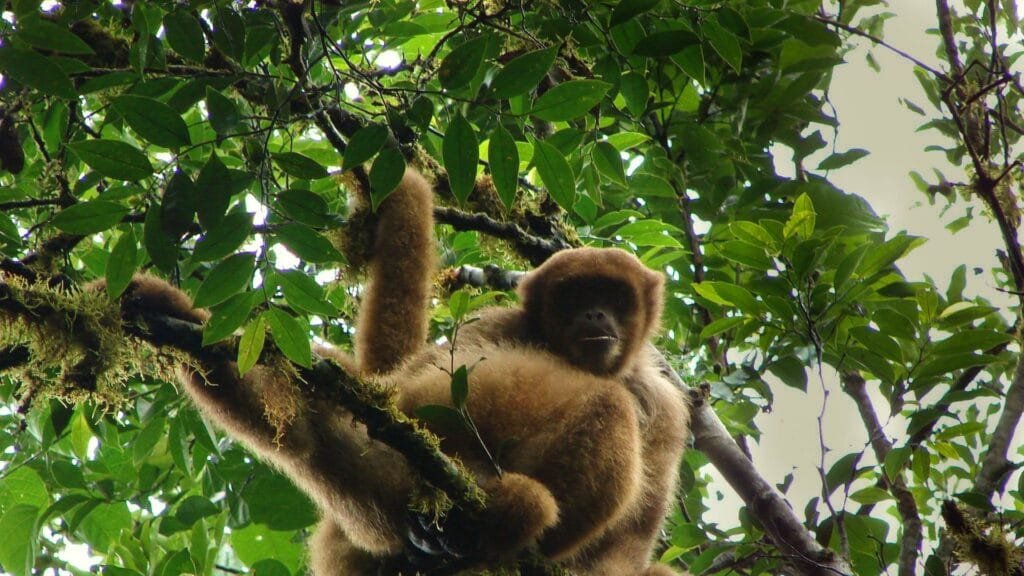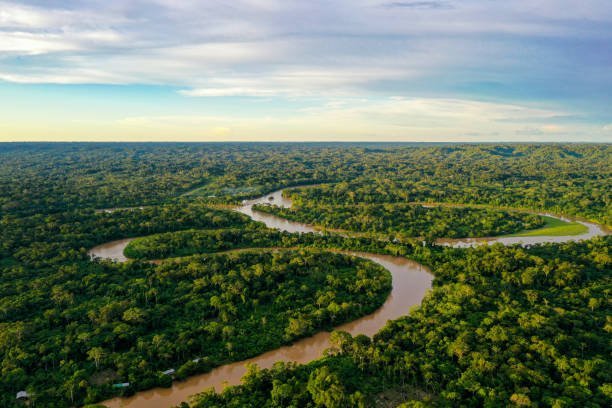Amazon Travel Itinerary
The Amazon, the beating heart of the world’s largest tropical rainforest, offers a unique and immersive experience for those willing to uncover its mysteries. This 5-day, 4-night travel itinerary, starting from Manaus, is specially designed to provide intimate contact with the exuberance of Amazonian nature. A stay at a jungle lodge serves as the base to explore the impressive biodiversity and rich local culture.
During this time, visitors have the opportunity to delve into the dense forest canopy, where every sound, color, and smell of nature intertwine to create an unparalleled sensory experience. Daily excursions are planned to reveal the rainforest’s best-kept secrets, from wildlife observation to learning about medicinal plants used by indigenous communities.
The journey begins in Manaus, a vibrant city that serves as the gateway to the vast Amazon Rainforest. The adventure starts with the journey to the jungle lodge. This retreat provides the perfect base to rest after days filled with intense and enriching activities.
Get ready to navigate the winding rivers that cut through the forest, spot the spectacular Amazonian wildlife like pink river dolphins and sloths, and witness the intricate interactions of ecosystems that sustain countless species. Each day of the itinerary offers an opportunity to dive deeper into the natural wonder of the Amazon and understand the vital role this forest plays in the environmental balance of the planet.
In short, this journey represents more than just a trip; it’s a chance to reconnect with nature, learn about environmental preservation, and appreciate the cultures that inhabit these ancestral lands. It’s an experience that promises to transform any visitor, leaving an indelible mark on memory and heart.
Day 1: Arrival in Manaus and Transfer to the Jungle Lodge

Upon arriving in Manaus, the capital of the state of Amazonas, travelers are immediately enveloped by the vibrant atmosphere and welcoming warmth of the region. Located on the banks of the Rio Negro, Manaus serves as the gateway to the imposing Amazon Rainforest, and the city’s international airport is the starting point of an unforgettable journey.
After a warm reception at the airport, travelers are transported to the reserved jungle lodge, either by land or river. The river journey offers a first chance to appreciate the lush surrounding vegetation and the tranquility of the black waters of the Rio Negro, marking the beginning of direct contact with Amazonian nature.
Boats navigate the winding waterways until reaching the jungle lodge. This type of accommodation is unique to the Amazon, providing a complete immersion in the local flora and fauna. Along the way, it’s possible to spot various bird species and, occasionally, pink river dolphins, beloved inhabitants of the Amazonian waters.
Upon arrival at the jungle lodge, the reception is warm. The accommodation, though rustic, is comfortable and designed to harmonize with the surrounding natural environment. The first afternoon can be spent on an exploratory walk around the lodge, where a local guide introduces the plants and animals of the forest, along with curiosities about the culture and way of life of the Amazonian peoples.
At night, travelers enjoy a typical Amazonian dinner filled with local flavors, such as fresh fish, regional fruits, and peculiar delicacies. This first direct encounter with Amazonian cuisine complements the experience, providing an authentic and unforgettable taste. The nighttime calm of the forest, filled with natural sounds, is the perfect setting to conclude the first day of exploration in the heart of the Amazon.
Day 2: Jungle Trek and Wildlife and Flora Observation
The second day of this Amazon travel itinerary is dedicated to a guided jungle trek, offering a full immersion into the heart of the world’s largest tropical forest. As the walk begins, visitors are accompanied by experienced guides who share valuable knowledge about the local biodiversity.
During the trek, the guides provide detailed explanations about the medicinal plants found along the way. The traditional use of these plants in indigenous medicine is fascinating, reflecting the ancestral wisdom and deep connection of local communities with nature. Notable examples include copaiba, known for its anti-inflammatory properties, and cat’s claw, with its potential to boost the immune system.
The jungle journey also includes the observation of diverse wildlife. A stunning variety of colorful birds, such as the iconic toucan with its vibrant beak and macaws that fill the sky with radiant colors, can be seen. Mammals like monkeys and sloths also make appearances, offering unforgettable moments of wildlife contemplation in their natural habitat.
As the trek goes deeper into the forest, jungle survival techniques are demonstrated, teaching visitors how to identify safe sources of water and food, as well as basic methods for building shelters. This practical knowledge can be vital in fostering a greater appreciation and respect for the Amazonian environment, showing how it’s possible to live sustainably in harmony with nature.
The encounter with the Amazon’s diverse flora is equally impactful. Dense areas of vegetation, towering trees, and an endless variety of endemic plants create a breathtaking scene. Interaction with this ecosystem reinforces the importance of conservation and a deep understanding of the natural interconnections that sustain life in the forest.
With every step on the trail, the jungle reveals fascinating secrets about its species and the ecological interdependence that characterizes it, making this day an educational and transformative experience in the exploration of the Amazon.
Day 3: Visit to Riverside Communities and Local Culture

The third day of the Amazon itinerary offers an immersion into the essence of riverside life, giving visitors the opportunity to explore traditional communities located along the majestic Amazonian rivers. These visits provide a window into the authentic local culture, where you can observe and participate in everyday activities such as fishing, farming, and animal husbandry—essential elements for the subsistence of these communities.
During the tour, visitors have the chance to discover vibrant local handicrafts, unique pieces made from materials available in the region, such as palm fibers, seeds, and clay. These crafts are not only beautiful souvenirs but also a way of preserving and promoting the cultural identity of the riverside dwellers. The enriching interaction with local artisans not only values their work but also encourages sustainable tourism, which is crucial for maintaining traditions and supporting the local economy.
Beyond the material aspects, the day is marked by the sharing of stories and legends passed down through generations, which portray the mythology, customs, and worldview of Amazonian inhabitants. This cultural exchange enhances the travel experience, allowing visitors to understand and respect the deep connection the riverside people have with nature.
The importance of sustainable tourism is a central theme during the visit. Well-planned and responsible tourism can bring significant benefits to these communities, from job creation and income generation to improvements in local infrastructure. However, it is crucial that these benefits are achieved in ways that respect and preserve traditions and the environment. Conscious and respectful interactions are essential for visitors to appreciate the cultural and natural riches of the Amazon while leaving a minimal footprint in their wake.
Day 4: Canoe Ride and Nighttime Animal Spotlighting
The fourth day of our Amazon travel itinerary promises experiences that combine tranquility and adrenaline. In the morning, visitors embark on canoe trips to explore the igarapés and igapós, intricate networks of channels and flooded forests. These waterways require specific skills from the guides, who master navigation techniques in densely wooded environments, ensuring safe and informative tours.
Canoeing through the igarapés allows for quiet approaches to nature, ideal for birdwatching. The Amazon is a paradise for ornithologists, with species like the golden parakeet, harpy eagle, and musician wren available for observation. The ability to hear the subtle sounds of the forest, without the interruption of engines, enhances the experience of connecting with local biodiversity. In addition to birds, it’s common to observe monkeys, sloths, and various types of fish inhabiting these channels.
The excitement of the day transforms into a mix of anticipation and fascination at night, with nighttime animal spotlighting. This is when the Amazon reveals its nocturnal creatures. Using special flashlights, guides help visitors identify uncommon wildlife. Searching for caimans is one of the most thrilling activities. The glow of these reptiles’ eyes, reflected by the flashlight, creates a unique atmosphere as the guides share information about their habits and behaviors.
Other predators, like the jaguar and anaconda, may also be spotted, though such encounters are rarer and require silence and caution. Nighttime spotlighting offers a different perspective of the forest, showing how life renews itself after dark. The shadows and sounds that emerge as night falls complete a memorable journey, illuminating the mysterious depths of the Amazon.
Day 5: Piranha Fishing and Return to Manaus
The fifth day of our Amazon journey begins with an exciting and culturally rich activity: piranha fishing. After a hearty breakfast at the camp, travelers are led to specific areas where piranhas are abundant. Equipped with traditional fishing rods and bait, you’ll learn local fishing techniques, an experience that offers an authentic connection with the customs of the region’s riverside communities.
Piranha fishing not only provides a sense of adventure but also helps to understand the importance of this fish in the diet and economy of Amazonian communities. It’s a moment of immersion in nature, accompanied by the singing of birds and the calm of the Amazonian rivers, creating an unforgettable memory.
Next, the group returns to the floating hotel, where lunch is served. This is the ideal time to exchange experiences with other travelers, share stories about the wildlife and flora observed, and perhaps enjoy a meal that includes the piranhas caught.
After lunch, it’s time to check out and prepare for the return trip to Manaus. Transport will be available, usually via fast boats or smaller vessels, ensuring a comfortable and safe journey. During the return trip, there will be opportunities to admire the contrasting landscape of the jungle, a visual farewell to the majestic tropical rainforest.
Arrival in Manaus marks the end of this enchanting Amazon itinerary. The last moments of the trip can be spent mentally revisiting the most memorable moments, from exploring the diverse flora to surprising encounters with the local wildlife. This is an itinerary that will undoubtedly leave lasting memories and an inspiring desire to return to the Amazon.
Amazonian Cuisine: Unique Flavors of the Forest

Amazonian cuisine is a feast of novel and surprising flavors that captivate visitors right from the first encounter. During their stay at the jungle lodge, travelers have the opportunity to explore a wide variety of local delicacies, defined by typical ingredients and authentic preparation methods practiced by the region’s cooks.
One of the most striking elements of Amazonian cuisine is the exotic fruits. Among them, açaí stands out not only as a delicious treat but also as a highly nutritious food. Another unique fruit is cupuaçu, with its creamy pulp that results in delicious juices and desserts. Tucumã, with its peculiar flavor, often enriches snacks and meals.
The abundant waterways of the Amazon are reflected in the extensive use of regional fish. Species such as tambaqui and pirarucu take center stage in many dishes. Tambaqui, known for its tender and juicy meat, can be grilled over an open flame, providing an irresistible smoky flavor. Pirarucu, the “Amazonian cod,” receives similar treatment with smoking and marinating techniques that enhance its flavor.
The authenticity of Amazonian cuisine is also evident in traditional preparation methods. The “moquém” technique, where fish is roasted wrapped in leaves, ensures a natural flavor and a rustic presentation that fascinates tourists. Another typical method is the use of “tucupi,” a broth obtained from wild cassava, often used to cook fish and meats, adding a unique depth of flavor to meals.
Exploring Amazonian cuisine is undoubtedly an experience that transcends taste, offering a true cultural immersion into the richness and diversity of the forest. Each meal becomes a celebration of the unique flavors that only the world’s largest tropical rainforest can offer.

Tips and Recommendations for an Unforgettable Amazon Experience
A trip to the Amazon requires proper preparation to ensure a safe and memorable experience. First, when packing, prioritize lightweight, quick-drying, neutral-colored clothing that helps with camouflage during excursions. The use of hats, sunglasses, and long-sleeved clothing is also recommended for protection against the sun and insects.
Another essential item is insect repellent. The Amazon region is known for its rich biodiversity, including insects like mosquitoes that can transmit diseases. Therefore, it is essential to apply repellent regularly to ensure your health and comfort. Using high-protection sunscreen is equally crucial, given the tropical climate and high sun exposure.
Don’t forget to bring a camera capable of capturing the unique beauty of the Amazon. For photography enthusiasts, cameras with telephoto lenses are ideal for capturing the diverse wildlife that inhabits the region. Also, bring plastic bags to protect your electronic devices from moisture and water.
To ensure your experience in the Amazon is safe, follow some recommendations: always be accompanied by an experienced local guide, inform someone of your itinerary, and avoid interactions that may disturb the wildlife. Appreciating the natural beauty of the Amazon responsibly is crucial to the preservation of the ecosystem. Respecting the flora and fauna not only values wildlife but also ensures the sustainability of the region.
When planning your trip, consider the best time of year to visit the Amazon. The period between June and November is generally the most recommended, as it is the dry season, making forest hikes and wildlife viewing easier. Additionally, boat trips are more enjoyable during this time, providing a more pleasant and safer experience.




No responses yet